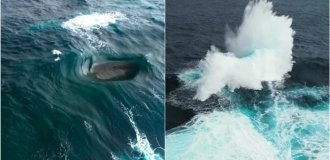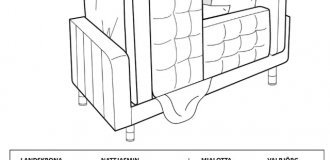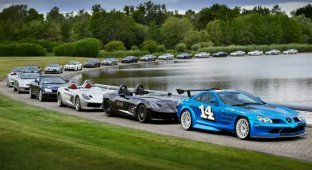Some of the most technologically advanced ships of their time. Sverige-class armadillos (6 photos)
The Swedish Navy in the 20th century, although inferior to the fleets of the leading maritime powers, was still considered powerful and quite numerous. The core of the forces in the interwar period and later, during the Second World War, were three coastal defense battleships of the Sverige class. 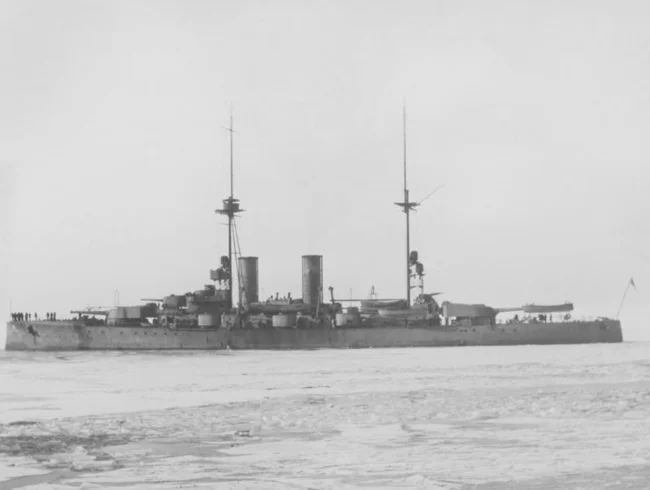
The coastal defense battleship Sverige shortly after commissioning, 1918
The beginning of the 20th century was a period of complications for Sweden. In 1905, the Swedish-Norwegian union collapsed, and tensions between Germany and Great Britain were growing. In the event of a war between these countries, the Baltic Sea would become a combat zone. The Swedes did not intend to fight, but they had to ensure some protection for themselves, and the ships they had could not reliably guarantee this.
The Swedish navy had only one battleship, Oscar II, and four Eran-class battleships. However, the rapid development of scientific and technical thought and the dreadnought race gave reason to believe that this was too little. In 1911, parliament voted to finance the construction of a new ship with a displacement of 4,800 to 7,500 metric tons, but the decision was stalled by the efforts of Prime Minister Karl Staaff.
A public campaign to raise 12 million kroner for the ship was launched with the support of Gustaf V. In just three months, 15 million kroner were raised, an impressive achievement. Staaff was forced to put the project into motion, and the ship, named Sverige, was laid down on 12 December 1912 at the Götaverken shipyard in Gothenburg.
After the outbreak of World War I, the new Prime Minister Hjalmar Hammarskjöld put forward the idea of building two more battleships to the same design with minor modifications. His idea was accepted, and in July 1915, Drottning Victoria was laid down in Gothenburg, and in the spring of 1915, Gustaf V was laid down at the Kockums shipyard in Malmö.
It is not surprising that some of the ships' performance characteristics differed. Thus, Sverige had a full displacement of 7,516 tons, a length of 119.7 m, a width of 18.6 m and a draft of 6.2 m, while Drottning Victoria and Gustaf V had a full displacement of 7,633 tons, a length of 121.6 m, a width of 18.6 m and a draft of 6.2 m. The increase in length was due to the installation of an inclined icebreaker bow. The power plants also differed. On the first ship of the series, it had a capacity of 20,000 hp and consisted of four Curtis direct-drive steam turbines, each of which drove one propeller shaft. And the following ones had a capacity of 22,000 hp, the power plant consisted of two steam turbines with a Westinghouse gear transmission. Thus, these ships became the first and last coastal defense battleships with a steam turbine plant. All three battleships had 12 coal-fired Yarrow boilers and could reach a speed of 22-23 knots. 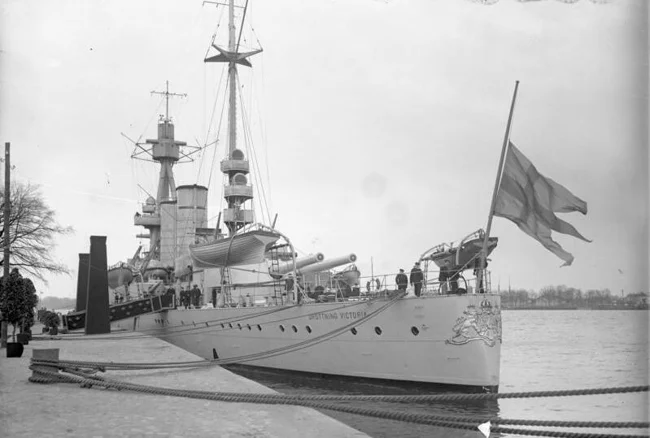
Drottning Victoria in Stockholm, 1930
The armament and armor were also identical. Thus, the main armor belt had a thickness of 200 mm in the central part, tapering to 60-100 mm at the ends. The upper belt had a thickness of 100 mm, but covered only the central part. The turrets and barbettes of the main and secondary calibers had a thickness of 100 to 200 mm, the conning tower - 175 mm.
The main armament consisted of 2×2 283 mm/45 guns, the secondary consisted of 152 mm/50 guns, arranged in 1×2 and 6×1 on Drottning Victoria, 1×2 and 4×1 on Sverige and 6×1 on Gustaf V. The armament was supplemented by 4×1 75 mm Bofors anti-aircraft guns, 2×1 57 mm short-barreled Bofors guns, 9×1 6.5 mm machine guns and 2×1 underwater 457 mm torpedo tubes.
Sverige was launched on 3 May 1915 and entered service in May 1917. The situation with the remaining ships of the class, laid down in 1915, was different. Due to the war, Sweden was unable to receive the armor plates it had ordered from the United States for a long time, and there was a labor shortage. So Drottning Victoria was launched on September 15, 1917, and Gustaf V on January 31, 1918. They were not completed before the end of the war (November 1918). In the wake of the peace agreements, a number of influential Swedish people proposed removing the armor from these ships and completing them as passenger ships.
And yet, both battleships were completed as warships and, after sea trials, entered service in 1921. Sweden intended to use the Sverige-class battleships against its new neighbors - Finland, Latvia, Lithuania, and Estonia. For this purpose, the battleships conducted active exercises throughout the first half of the 1920s.
In general, the Swedish Navy command developed a special doctrine for combat operations. Despite the fact that the Sverige class was a coastal defense ship, it had powerful weapons, thick armor, and good speed for its type. Therefore, it was supposed to use them both in shallow water in bays and in the open sea as part of squadron forces - like classic squadron battleships or battleships. 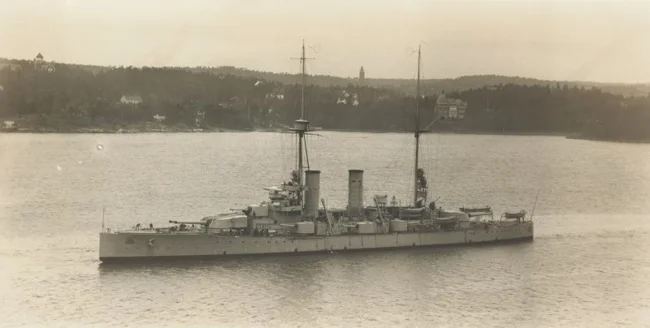
Coastal defense battleship Sverige in 1931
In 1924, Gustaf V and Drottning Victoria with four destroyers made an official visit to Tallinn, and then, leading a squadron of 36 ships, to Helsinki. In 1926, Gustaf V and Sverige visited Copenhagen to participate in exercises. In 1930, the body of Queen Victoria, who had died shortly before in Rome, was brought to Sweden from Swinemünde on board Gustaf V.
The three battleships were regularly modernized, during which they all received various changes. For example, the torpedo tubes were removed. Sverige received a new Dutch rangefinder and new anti-aircraft guns in 1931–33, and the boilers were converted to mixed heating. During the ship’s modernization in 1938–40, all Yarrow boilers were replaced with four Penhoët oil-fired boilers.
Gustaf V underwent a major modernization in 1927–30: the forward mast was replaced with a tripod, on which an observation post and a rangefinder were placed. The height of the mast was reduced, and the ventilation system was improved. In addition, a new deckhouse was installed on the superstructure in the stern to accommodate living quarters and equipment, and an expanded bridge was built for the naval commander. An anti-aircraft artillery control post was also installed, and the two forward pipes were combined into one. The boilers were converted to mixed heating. 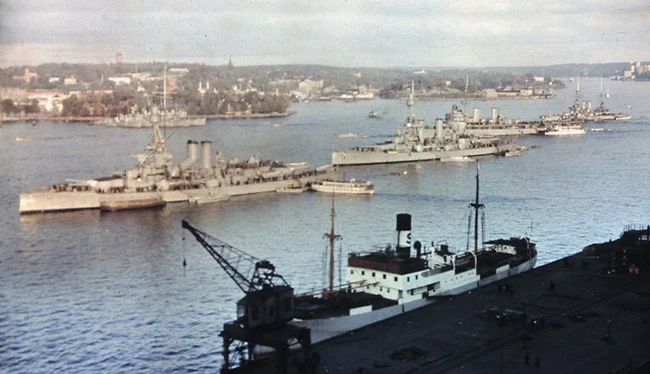
Battleships Drottning Victoria and Sverige (in the foreground) and cruiser Gotland in Stockholm, 1937
Drottning Victoria underwent a minor modernization in 1935, during which new rangefinders and anti-aircraft guns were installed and the boilers were converted to mixed heating. These works proved insufficient, and by 1940 plans were drawn up for a new modernization by redesigning the superstructure, increasing the elevation angle of the main caliber guns to 32 degrees, and replacing the light armament with two twin 57 mm guns and 12 40 mm/56 Bofors guns in 4 twin and 4 single mounts, as well as 10 25 mm Bofors mounts. This more than doubled the power of anti-aircraft fire, but the plans were never implemented.
After the modernization, the battleships continued relatively active service. In March 1939, all three ships took part in large-scale naval anti-aircraft exercises. On March 7, while landing in the dark, one aircraft collided with the mast of Gustaf V, killing two people. 
Drottning Victoria at the scrapyard in Karlskrona, 1959
Soon, another incident happened with this ship. With the outbreak of World War II, Gustaf V became the flagship of the Coastal Fleet and in this capacity on 17 July 1940, she took part in maneuvers west of Gotland, during which one of the boilers exploded on board. As a result, eight people died in the boiler room, and two more died from burns received from steam escaping from the air intake on the deck. The battleship then spent a month in the Stockholm shipyard undergoing repairs, and the status of flagship passed to Sverige.
Sverige remained the flagship until 1947, when she was modernized and fitted with radar equipment. Similar work was later carried out on the other ships. Obsolescence was taking its toll, and Sverige was decommissioned on 30 January 1953 and sold for scrap in 1958. Drottning Victoria and Gustaf V were decommissioned a little later, on 1 April 1957. However, while Drottning Victoria was cut up for scrap in 1959, Gustaf V remained at Berg naval base, south of Stockholm, as a mooring point for destroyers and transports until 1970. Its two 152 mm guns were removed and installed at Heggmansberget. 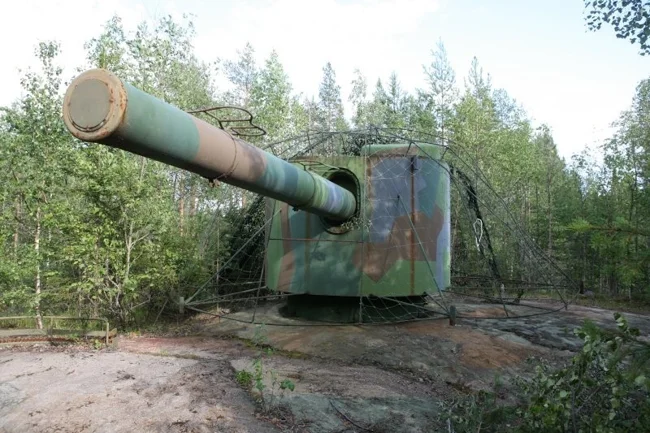
152 mm auxiliary gun of the battleship Gustaf V in Heggmansberget, 2010
Thus, although the Sverige-class battleships did not participate in combat, their appearance had a significant impact on the political situation of Sweden in general and its navy in particular. Being among the largest representatives of their class, and also having a steam turbine power plant, they were among the most technically advanced ships of their time.
